Chef Magnus Nilsson returns to the remote Faroese island of Stóra Dímun, where modernity and ancient traditions collide.
I feel a sinking sensation of falling as a strong and rugged hand grabs ahold of mine just as the deck of the boat falls away to a subsiding north Atlantic swell. A brief moment later, my boots crunch firmly down on a limpet-encrusted boulder, and I am saved. I am surrounded on three sides by crystal clear turquoise water, but have not fallen in.
I look up toward the man attached to the hand I am still holding. Jógvan Jón greets me with a smile and a short phrase in heavily accented Danish, “Be careful Magnus, the stones are slippery.”
The island is a perfect natural fortress
It is my second time here on the island of Stóra Dímun, a truly remote place. First you have to get to the Faroese archipelago, in the middle of the ocean about halfway between Iceland and the very northernmost point of Scotland. Then it’s either a thirty-minute helicopter ride from tiny Vágar airport or, as today, a two-hour boat ride from the Faroese capital of Tórshavn. And because of the way the 2.6 square km island itself is shaped, it is almost impossible to access. Swept for eons by eroding ocean currents that polished its volcanic rock and created steep cliffs which drop straight into turbulent seas, the island is a perfect natural fortress.
Stóra Dímun has no beach and no harbor, so actually landing a boat is impossible. To disembark, you have to jump onto one of two carefully selected boulders as the unmoored craft reaches the apex of a swell and rests still for a short second. The two boulders are as close as the islands have to a dock, chosen for their size and proximity to a rope that you will then have to use to climb the roughly 200m high cliffs.
As I am just beginning to contemplate how to haul myself, along with my gigantic yellow duffel bag containing clothing and camera gear, up the vertical escarpment ahead of me, I see Jógvan Jón, now also joined by his father-in-law Óla Jákup, unroll a sheet of rough burlap. The men tie the meter-long cloth securely to the handles of my bag and then Jógvan Jón hoists the whole thing up on his back. My ungainly luggage is apparently going to be kept in place, not by his shoulders as I first assumed, but rather by the burlap pulled over his forehead. The muscles of his neck carry the heavy load, leaving his arms and shoulders free for climbing.
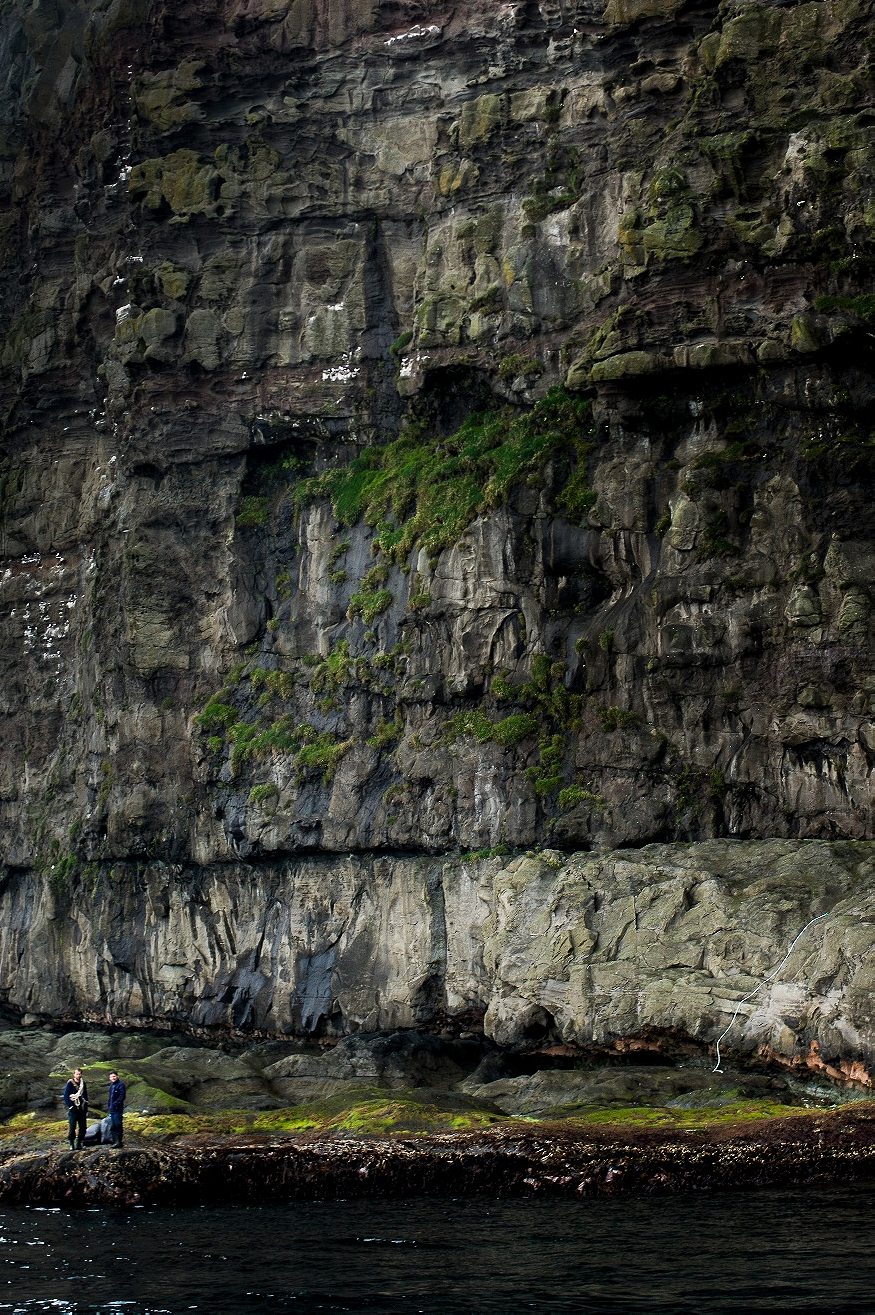
Jógvan Jón takes the lead and we begin the ascent. About halfway, I look down and feel my stomach turn. The drop below doesn’t end in solid ground, but rather in crashing waves and churning water. The movement below makes me feel as though I myself am moving, like watching a running train from one stopped at the station. For a brief second, before your mind tells you that you are in fact standing still, it feels like the opposite.
At the top of the cliffs, a little blue tractor with a hayfork attached to its front is waiting for us, idling. Jógvan Jón balances my yellow bag on the tractor’s steel prongs, I sit alongside, and we make our way to the house.
As the tractor pulls up in front of the ancient stone walls, a faint scent catches my nose, like lost strands of music barely audible though the wind. It’s not a delicate piano etude or a flatteringly engineered and edited modern pop song. Rather, the scent carries a notion of ancient times, of winter storms, of hardship and endurance all the way back to the Viking ages—it is the scent of Skerpikjøt.
Skerpikjøt is the traditional preserved (or perhaps rather kept) meat from places where salt hasn’t been affordable or even available for more than a few hundred years. The Faroese climate is too cool to evaporate seawater in salterns and there is no naturally growing wood on the islands to fuel saltpans. This situation, combined with their remoteness, especially during the era of sailing ships, has historically made salt a rare and expensive commodity.
The Faroese practice of producing Skerpikjøt basically by hanging pieces of raw, unsalted mutton in an airy house called hjallur. The meat is left until it has either reached the desired maturity, or until it is needed. The country’s location in the middle of the Gulfstream makes the climate quite humid, and so completely drying a piece of meat is a very lengthy process often taking more than one full year.
There are three stages of maturation in Skerpikjøt production, called hjaldane. The first is called visnadur and takes place after a few days. The Faroese name for this stage literally means “wilting,” and it is what most would refer to as dry aged meat. If it is eaten at all, it must be cooked. The next step, raestur, is a stage that depends on atmospheric factors like humidity and temperature. To the unaccustomed palate, raestur is pretty much decaying meat. Covered in a thick crust of mold and smelling intensely of putrefaction, it is consumed raw or cooked, warm as a meal or cold on bread. The third and final step in the maturation cycle of Skerpikjøt is turrur, which means “dry.” Turrur is achieved when enough water has evaporated and the meat has become firm, like a saltless charcuterie. Surprisingly, turrur is far milder than raestur and is eaten raw in thin slices on bread.

People have lived on this spot for more than 1000 years, according to the Færeyinga Saga that marks its history. The two families who now live in the one house on the island are both 8th generation Stóra Dímun farming families. The house itself is very old in parts, and its grey stone walls almost look like they have grown out of the sloping land, harmonizing with the undulating fields surrounding the farm and contrasting sharply with the more angular wooden structures that make up the rest of the house.
The table has already been set. Jógvan Jón’s wife Eva welcomes me with a hug and asks everyone to sit down. Joining me around the table, which is heavy with braised Skerpikjøt, traditional Drýl bread and boiled potatoes are Jógvan Jón, Eva, Eva’s father and her two kids—a son Sproti (8) and daughter Døgg (10). Eva’s brother Janus and his family are not there; they have left for a short vacation in the capital, celebrating Ólavsøka, the Faroese national day.
The scent of Skerpikjøt is the scent of decay
It’s a funny feeling, eating something that you have to actively decide to put in your mouth. Consuming food is often something we do without thinking much. Usually when we have to make an active decision concerning the food we eat, we decide not to put something in our mouths, rather than the other way around. Thousands of years of wisdom, accumulated through natural selection, has taught us how to eat. In most cases we automatically detect what is good for us and what is potentially dangerous.
The scent of Skerpikjøt is the scent of decay. It is something our sensory organs are programmed to react negatively to. Simply putting a piece of the pungent meat in between your lips requires that you make up your mind to do it, override the nervous system and command your hand to put the little brown morsel in your mouth.
I am astonished every time I encounter Skerpikjøt and this inner conflict that it inspires. Even more astonishing is that I quite like the flavor of it.
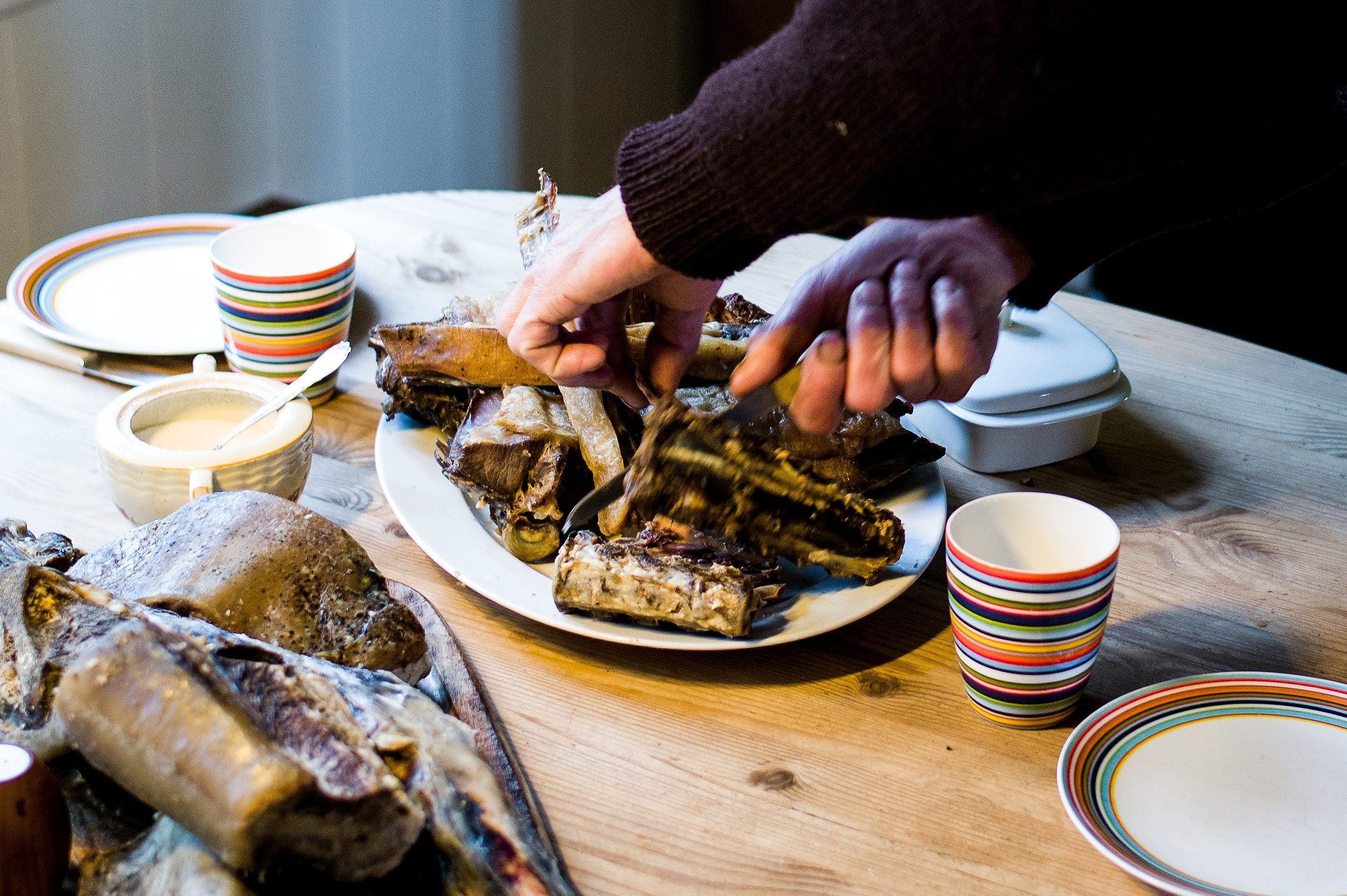
Among the Faroese, who have had these products in their diet for a long time, eating them is simply part of their programming. Their intuition doesn’t say, “This, my friend, is rotten,” but rather tells them to enjoy it, just as many central Europeans intuitively enjoy the taste of cured meats like Parma Ham, a food we have grown accustomed to over generations but which, like Skerpikjøt, is also made using a technique for keeping meat that was once developed out of necessity.
When attending a Faroese dinner party, among the appreciative sounds of eating, you can hear running commentaries on the meat— almost as if the diners were sommeliers discussing a good bottle of wine: “This shank clearly comes from Suderøy, you can feel it on the herbaceousnes.” Once you’ve overcome the instinctual barrier protecting humans from the hazards of eating rotting meat, a true connoisseur can sense a geographical difference between different pieces by detecting the taste of microbiological flora that inhabit the surface of the meat.
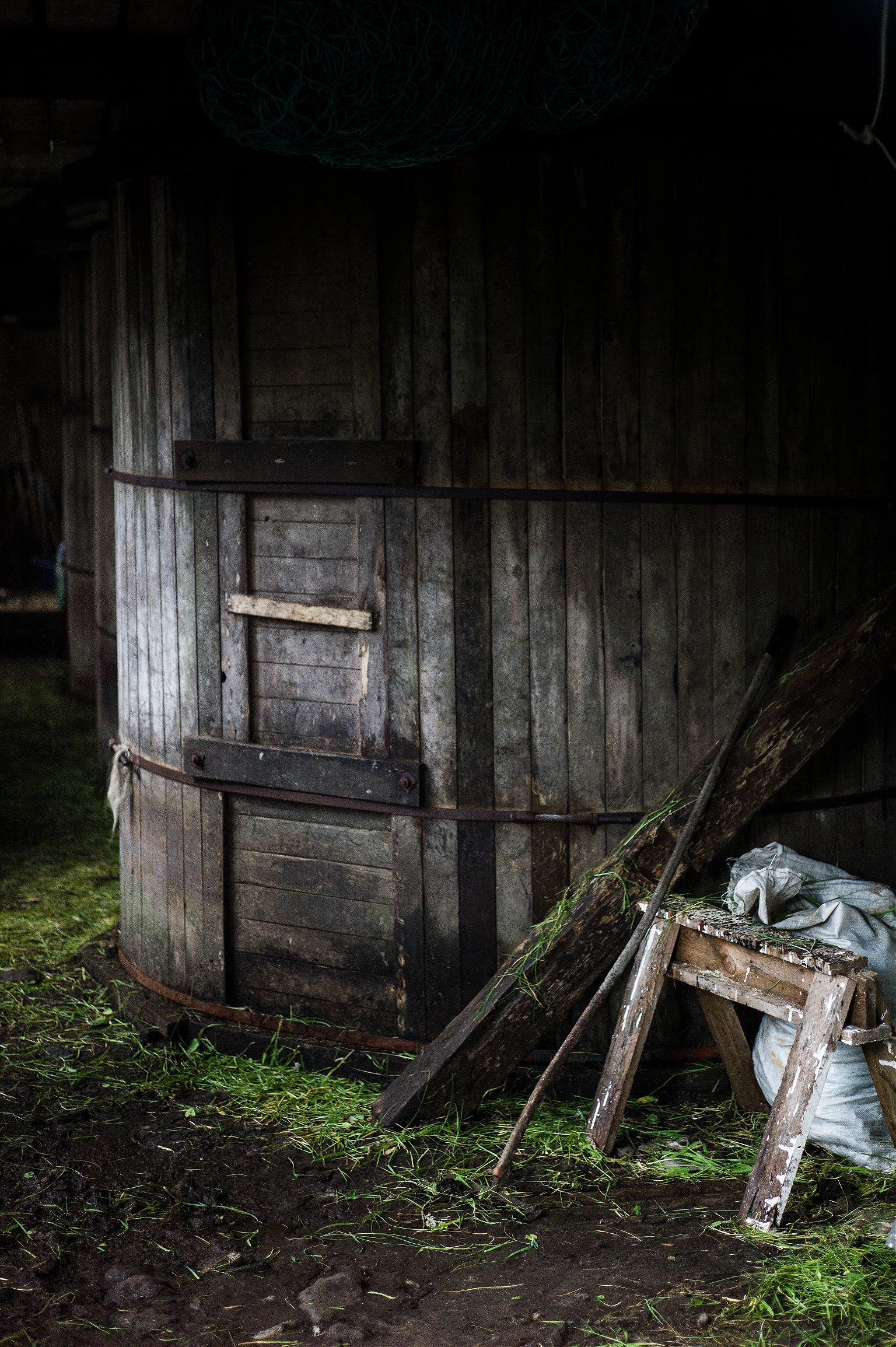
After a quick dinner, we all go out into the light Nordic summer night. This is the last day of harvesting grass to make silage, important feed for the livestock during the coming winter, and everyone will help out.
A low red barn with five wooden silage silos is connected to the main house by a narrow path of round stones that have been polished by thousands of footsteps. Four of the worn silos are already filled with green grass, topped with tarpaulins shaped into big balloons and filled with water to weigh the fermenting content down. The fifth and last in row is still barely half full.
I can hear the tractor approaching a few seconds before it arrives. Jógvan Jón is once again at the wheel as the vehicle unloads a stack of fresh, coumarin-smelling grass. The ground swells up to meet the backside of the barn, reaching the roof, so it is possible to load the silage by hand, tipping the grass down from above into the silos. Óla Jákup swings the hayfork expertly, releasing the green clippings evenly down into the black void of the silo, all while smoking a home-rolled cigarette.
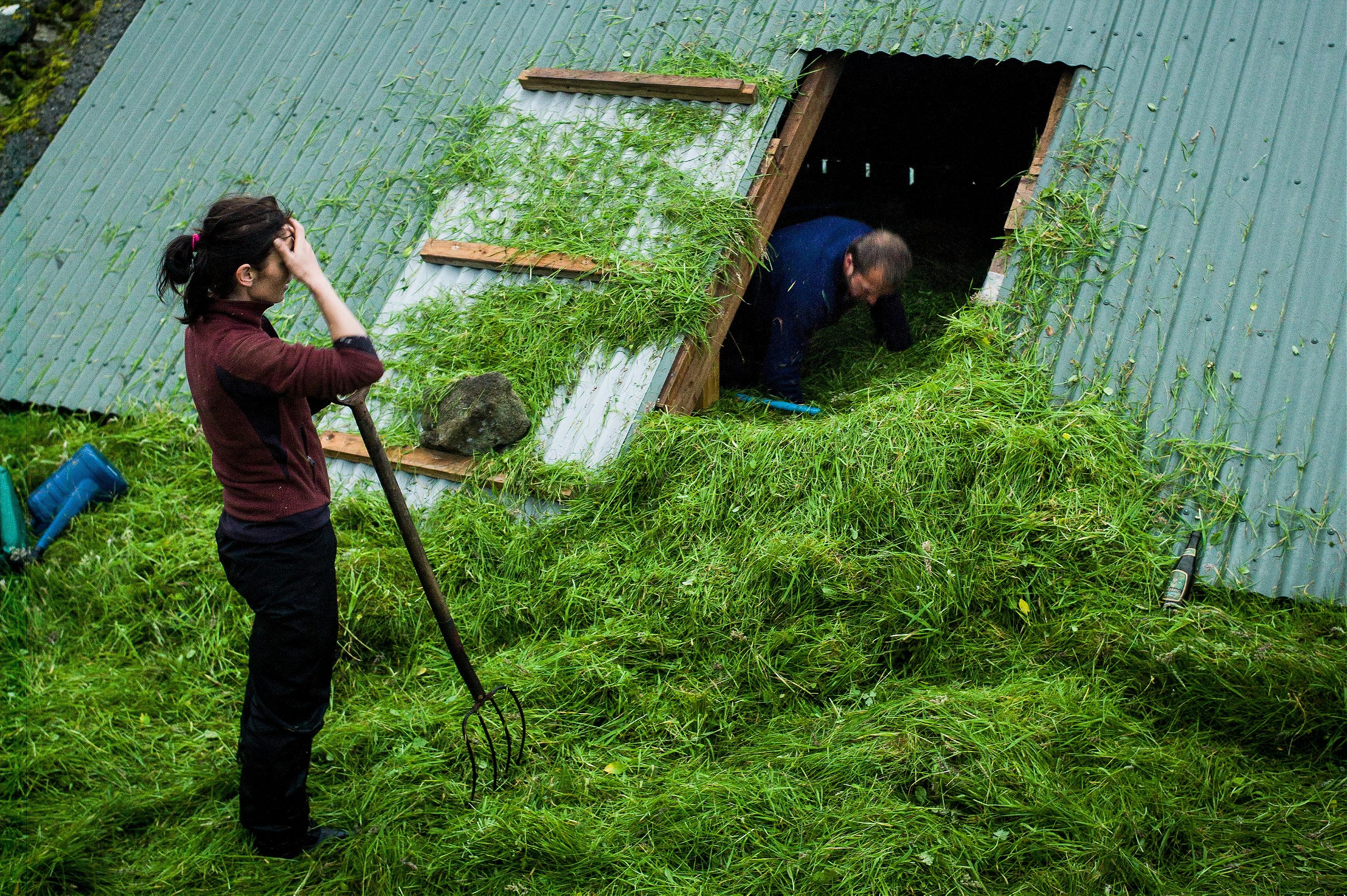
From time to time, one of us jumps into the silo through the slanted opening in the roof to walk around, the weight and the action of our feet compacting the grass, pressing out as much air as possible of the growing mound.
When the silo is almost full, Jógvan Jón and Eva disappear in different directions, Jógvan Jón on his tractor and Eva on foot. Óla Jákup picks up a blue plastic watering can and I wonder what he is doing. When he starts watering the grass resting in the wooden cylinder a smell emanates from the silo which instantly answers my question and fills me with memories from summers on my grandparents’ farm in northern Sweden an from preparing silage for cows to eat during winter. It is the intensely sweet and sour smell of formic acid working on green grass, lowering the pH-level and protecting the food from spoilage before the natural lactobacillus have converted enough of the sugars present in the plants to lactic acid which will offer the same protection.
Jógvan Jón comes back without the tractor and Eva comes back with some bottles of strong Faroese lager that we drink while seated on the stone wall behind the barn to mark the end of the work day. The air is cool and beautifully crisp, and the late Nordic summer light casts the steep cliffs surrounding the island in blue. The faint whirring sound of thousands of puffin wings in the distance is the only thing that isn’t silence. A bit later I am fast asleep in my room, rocked by the North Atlantic swells, which I can still feel in my body many hours after the boat brought me to Stóra Dímun.

I wake up to a sensation of extreme, almost tropical humidity, but weirdly cool instead of warm. I can see nothing out the window. The whole island is covered in dense, heavy fog. As I walk down the steep stairs from the second floor, I run into Eva, who asks if I want to help out with milking the cow.
A couple of generations ago, the inhabitants of the island had several dairy cows, and made both butter and cheese for sale. Today, the island’s last remaining cow is Gerda, kept mostly for company and to ensure a supply of fresh milk.
Eva sits down next to her cow on a little one-legged stool that looks almost as old as the stonewall of the house. She milks as we chat. She tells me that both she and Jógvan Jón where originally teachers, she in Faroese, mathematics, and history and he in music, mathematics, and physical education.
Eva has also gone to agricultural school in Norway and Jógvan Jón used to live in Denmark. Their decision to live on Stóra Dímun was not a matter of staying to take over the farm without ever seeing something else, but rather, a decision to turn back from one lifestyle and embrace an older, more fulfilling one. I ask Eva about schooling for their kids. She tells me that, as part of the Faroese policy of protecting the unique culture of the archipelago, the government supplies teachers and schooling to even the smallest islands.

A few years ago, when Døgg was about to start school, the family decided to build one themselves. The tarred black, grass-roofed house contains a classroom as well as a small apartment in which the teacher and his family can stay. The Faroese school system structures education in places like Stóra Dímun with a combination of on-site teaching, Skype broadcasts and six weeks each year at a school in the capital. Sometimes students from the larger islands also travel out to Stóra Dímun for a day or two to get their education in a different environment.
When Gerda’s udder is dry and empty, Eva takes the bucket of foaming milk and we make our way to the kitchen for breakfast. On the way, we pass a room called spískamar. It is a sort of roughhewn prep kitchen, combined with storage area for food and utensils. There, Eva sieves the milk though a very fine mesh and pours it into a large jug.
Other than the still tit-warm milk we drink, breakfast is: bread, rhubarb marmalade, cheese, butter and rullepølse, a cold cut meat first braised and then pressed in a wooden press.
Today is Sunday and that, in combination with the fog, makes it a perfect day to take it a bit easy.

Jógvan Jón tells me that he had been planning to go up to the plateau above the farm and gather one of the flocks of sheep that are grazing up there, but with all the fog there’s not really much use in trying. Instead I go out with Sproti to the vegetable garden. During breakfast, Eva talked about Sproti’s abilities in the garden and interest in everything that grows. She said he had green fingers. Sproti looked sternly at Eva and insisted they were all skin-colored.
Outside, the boy rushes across the lush green grass to get a shovel. When he comes back, he starts digging holes in uneven lines that roughly follow the wall a few meters away. When satisfied with his preparations he pulls up a little bag of seeds. Corn. It seems to me that corn would be one of the things that wouldn’t grow well on Stóra Dímun, especially if planted in late July, close to the end of summer. I say nothing—after all, I am certainly not the one with green fingers, and Sproti’s vibrating enthusiasm is enviable.
Faster than what seems possible, the planting is done. Sproti has gone elsewhere and left me with the shovel and a few small mounds of dark soil marking the future corn field.
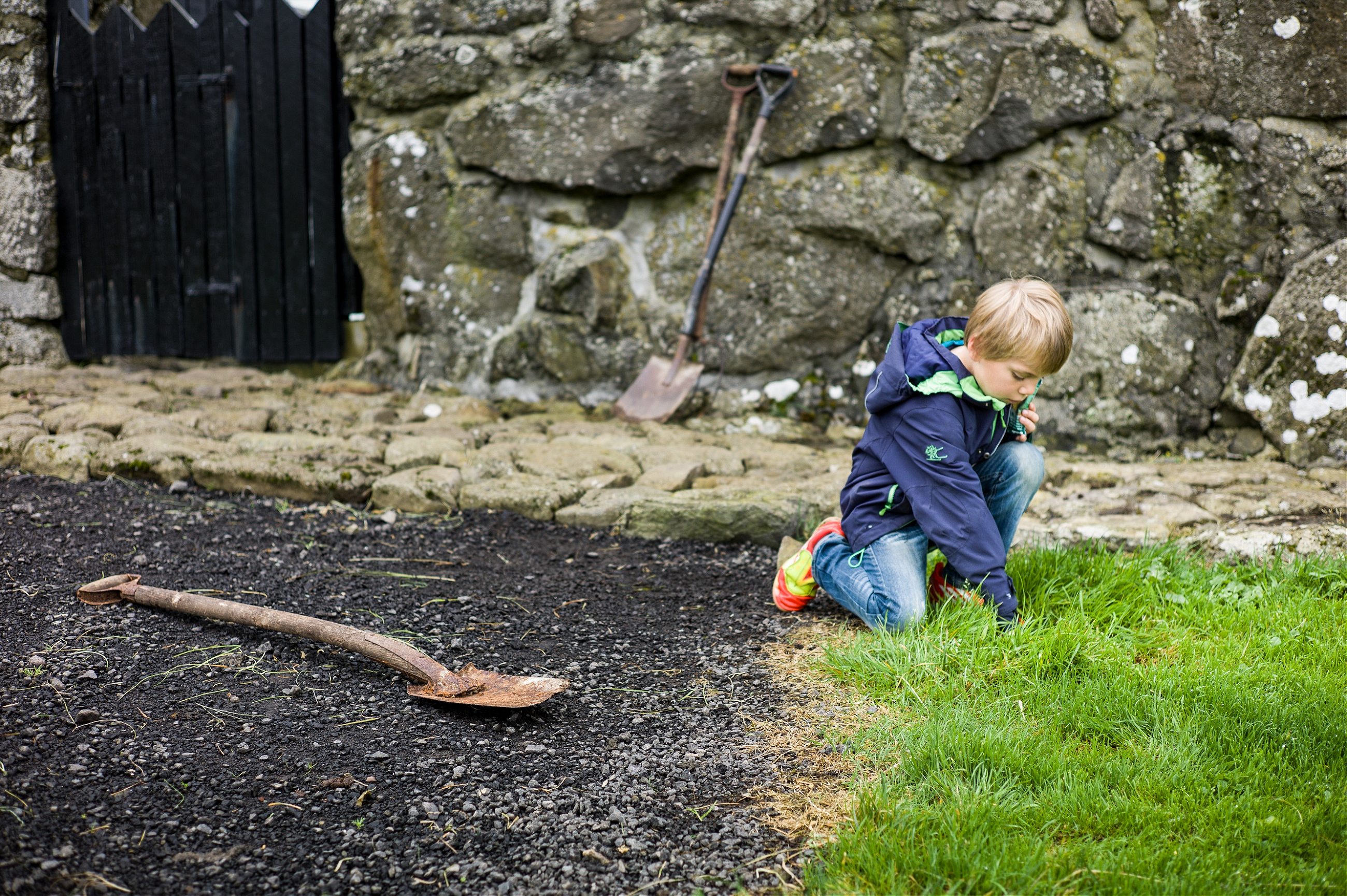
I walk around a little by myself and marvel over how lush the fields of this weathered island are. Some plants, like chickweed, have leaves roughly four times the size I am used to. It seems almost primordial, but I suspect this extraordinary fertility must instead be the result of many years of agrochemicals adding nitrogen to the soil and upsetting its natural balance.
At lunchtime, I enter the house again and I am met by laughter, and strange chirping and clicking noises. Standing in the middle of the kitchen is Jógvan Jón and Eva’s daughter Døgg with a young starling seated on her head. The little black bird happily sings as Døgg smiles. She tells me she found the bird outside and that she nursed it back to health. She had always wanted a parrot but this was close enough. The starling flutters around the room and settles again on Døgg’s father’s hand and they look at each other with fondness for a moment before the bird decides that the show is over, flexes its glossy wings, and leaves for its cage.
Lunch is served much like breakfast, with the addition of leftover Skerpikjøt, matured for half a year, braised yesterday and left in the spískamar over night, perfect as a sandwich topping.
In talking to Eva and Jógvan Jón, exchanging stories and experiences, I find that our lives are quite similar but also fundamentally different. We talk about politics, kids, farming and food. Finally, I ask about one of the most well-known Faroese traditions, the netting of puffin. It is something I have always wanted to see but it is considered a family matter and happens only during a short time of the year in just a few places. It turns out that this year, it was decided to stop hunting the parrot-like bird altogether due to severely diminishing numbers. Puffins were once vital to the diet of many Faroese families. Tens of thousands of birds where killed per year. Enough, I figure, to damage any population of wildlife. But Eva and Jógvan Jón, along with many other Faroese—people who lived for generations on the islands where puffins traditionally were hunted—say that the numbers of puffins culled from the flocks of the North Atlantic were stable for as long as anyone has records, and that the numbers went into steep decline only when commercial fishing started affecting the coastal waters.
Jógvan Jón tells me that not long ago it was possible to take a boat just outside of the island and catch hundreds of kilos of fish. Today you would catch almost nothing.
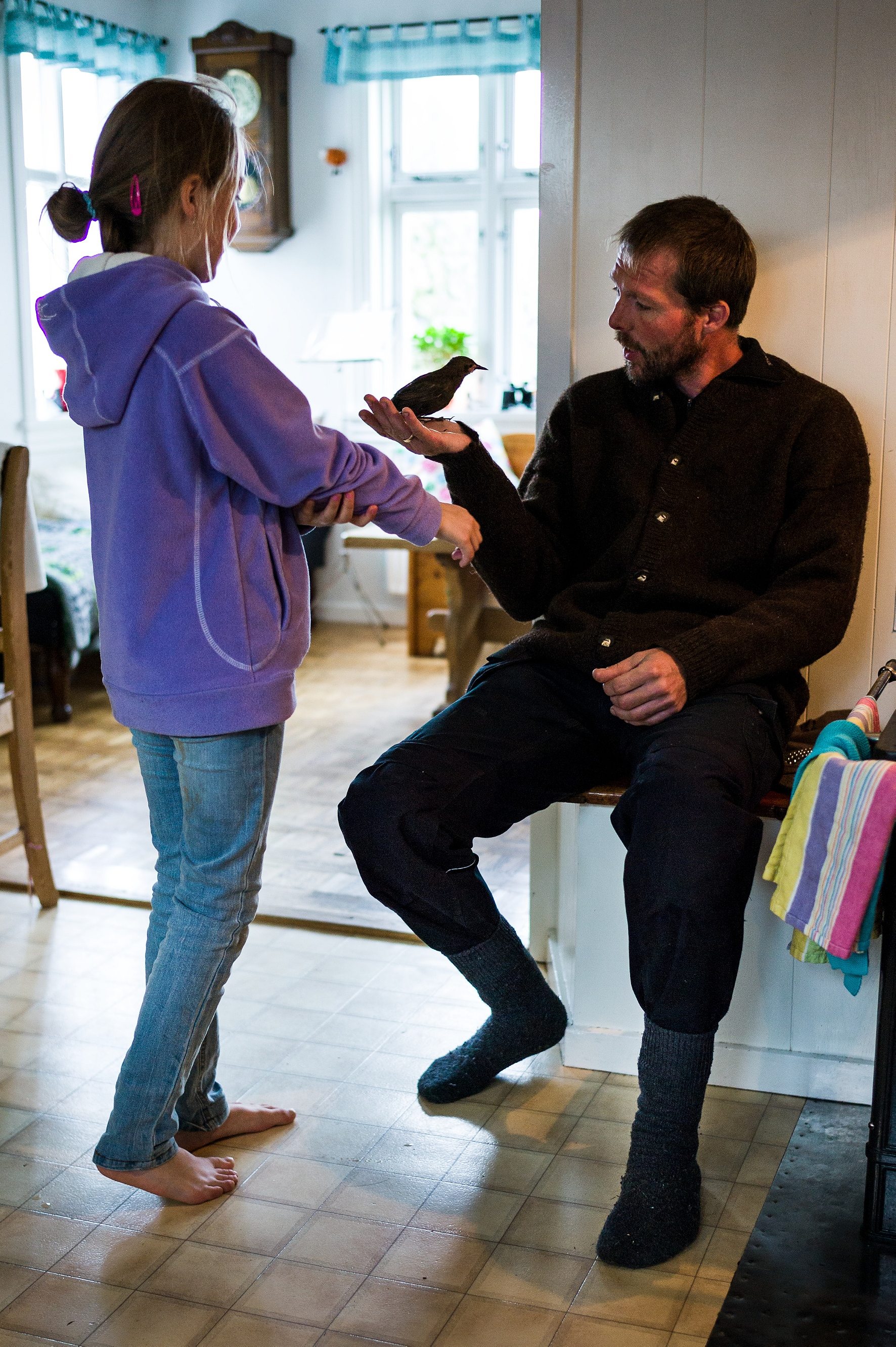
The puffin, if it doesn’t find enough tobis and other small and fatty fish to feed its offspring, skips hatching an egg altogether. Jógvan Jón tells me that he hasn’t seen more than a handful of puffin chicks over the last five or six years. The accumulative effect of low reproduction rates, bird culls, and natural demise due to predators and old age has made the situation impossible to maintain.
The decision to stop killing the birds was not taken by the government or by any other official body. It was taken by the affected landowners, collectively and voluntarily during grannastevna, a kind of non-legislating and ancient council of the Faroese landowners. The consensus was that even though most likely the yearly culling by the Faroese didn’t affect the population of millions of puffins back when they had plenty of food, now, with the shortage of fish and subsequent reduction of
hatchlings, it simply was not sustainable anymore. As the afternoon slowly turns into early evening, Jógvan Jón and Eva reminisce about flocks that used to be so large they darkened the sun, and hunts so successful that a thousand birds were caught in a matter of hours.
I finally find the courage to ask if, in spite of the current situation, it would be possible to take one of the nets I have seen resting on the rafters in the barn out and, perhaps, if I could just be shown how it used to be done.
I sense that it is a very delicate decision. Jógvan Jón stays silent for a moment. He then looks at me and explains that we will not kill anything and that I will have to be very careful in how I tell the story about this so that no one ends up in trouble. I agree. I want to see this ancient practice and to tell the story about the collective decision to stop hunting rather than describing the death (and flavor) of a bird.
The sensitivity comes in part because bird hunting in the Faroese archipelago is part of a larger dispute between the Faroe Islands, the European Union, and Norway about sustainable fishing quotas. The Faroese, having recently raised their own allowance for herring and mackerel by several hundred percent, were at the time of my visit being threatened with sanctions from mainland Europe. Most people I talked to on the islands acknowledge the diminishing fish stocks and the need to fish less.
But it seems the decision to unilaterally raise the quotas was pushed by politicians and lobbyists within an already-rich industry that benefits a few people in the short term, but could lead to a further collapse of the Faroese fish stocks. But these conversations don’t always go how you might expect: the fact that puffins can’t find enough Tobis has even been used as an argument in favor of raising the quotas of mackerel, as they prey on these tiny fish.
Jens-Kjeld Jensen, regarded as the foremost authority on Faroese seabirds, tells me that the catastrophic decline of not only puffins, but also of Guillemots, Terns, and Kittiwakes, is definitely due to lack of food. It’s not yet clear what triggered the decline of the Tobis, though, and adding to the mystery is the fact that the fish has never been commercially fished on the Faroe Islands. It is well established, however, that the decline of many other species in the area is due to overfishing. This, in concert with other still-unknown factors, affects the ecosystem in ways that we can’t yet understand, ways that lead to unexpected consequences like the decline of the most important food for the most iconic Faroese birds.
It’s like an enormous lacrosse stick, designed to carefully scoop up living birds midflight
After dinner we leave the warm and cozy house, stop by the cowshed to get the long-handled net, and leave for the cliffs. The green pastures end abruptly at the steep sides of the island, and we are surrounded by empty air. The net is roughly six meters in length, with a flexing handle that finishes in a shallow nylon web. It looks a little like an enormous lacrosse stick, but designed to carefully scoop up living birds midflight rather than rubber balls.
“There aren’t many birds tonight,” says Jógvan Jón, as he points toward the scenery in front of us. A few bright beaked puffins fly from their burrows, down to the water or up toward us. “Look,” he says, “None of them have any fish in their beaks.” I watch for fifteen minutes, and not a single bird returns from the surface of the calm sea with food.
As we near the cliffs, Jógvan Jón carefully works his way down to the very edge of the steep drop. I stay behind, about ten meters from where the gently sloping grass turns into vertical stone. Just as it seems he can’t get any closer to the edge, Jógvan Jón crouches behind a little green mound and holds the net out, business end hanging in the air to the right of him, the handle almost tracing the edge of the cliff itself.
I hear a sound, almost like when a kid straps a piece of cardboard to the frame of his bicycle so that it makes the sounds of a motorbike as it hits against the spokes. The sound, brrrrmmm, lasts for a brief second before a black and white bird with a multicolored beak lands just a few meters away from me with a slight, not very graceful thud. It looks at me, straight in the eye, and reminds me of an immaculately dressed and very polite older man, oddly wearing a circus mask with his tuxedo. After a few seconds the little bird decides that I seem rather friendly and disappears in its burrow.
We wait a bit longer, and after throwing his net out a few times in a broad, sweeping arc, missing birds that are just a little too far away, Jógvan Jón tells me, “The wind is wrong now, it makes them drift too far from the cliffs and too fast.”
As he utters the last word, a small flock of birds zooms by outside of the escarpment like lead pellets fired from a shotgun, and the net flies out as if it was a part of Jógvan Jón’s own body, responding by reflex to the rapidly approaching puffins. One of the birds’ flight path corresponds with the trajectory of the net and it stops midair. Not abruptly, but decelerating as if in slow-motion, the net’s long handle flexes and softens the impact a lot more than I expected. Jógvan Jón takes the net in, checks the bird for any sign of injury and releases it, a few seconds later it is on its way again, catching up with the rest of its flock.
As we walk back, we talk about the puffins, the decision to stop hunting them, and the fishing. Jógvan Jón asks me if I have ever tasted puffin. I haven’t. Jógvan Jón tells me about the traditional way of cooking them, filled with cake batter and raisins, and how he prefers them without the filling, just cooked in salt water, letting the integrity of the bird’s flavor remain intact. Even though he does not even come near to suggesting it, I sense that few things would have made him happier than getting the chance to share this ancient tradition with me by actually taking a few birds home with us home to eat, testing the two recipes.

The morning of my third day on Stóra Dímun brings with it clear and beautiful weather, which means that the helicopter can land on the island. Another part of Faroese government support for the outer islands, these helicopters travel to a handful of locations three days a week. The heavily subsidized ticket to Tórshavn is about 35 Euros. The practice of allowing its population easy access by helicopter to and from certain locations within the country started in 1984 and has been one of the most important factors in keeping the most remote settlements populated. People, goods, and necessities purchased in the capitol are all transported on these flying buses.
I can feel the kids’ excitement in the air as the helicopter approaches
This morning the helicopter is scheduled to bring groceries and fuel as well as two friends of Døgg and Sproti, Bjørt and Jóhanna. They are to stay on the island for a few days and I can feel the kids’ excitement in the air as the helicopter approaches.
As soon as the aircraft touches ground, the rotor starts slowing down to an idle and the doors open. Two children jump out and close the door behind them as casually as if it were the door of their parents’ station wagon dropping them of at school, and wave a thank you to the pilot. Against the backdrop of the noisy machine taking off again, the four children run toward each other for hugs, and right then, I can see one of the sides of life on Stóra Dímun that is less appealing to me. It must be difficult to grow up there, with little interaction with other children. Or perhaps it just makes the time you spend with others more precious and appreciated. I think about my own childhood running from house to house in small town suburbia in northern Sweden, playing with different children and grown-ups almost every day.
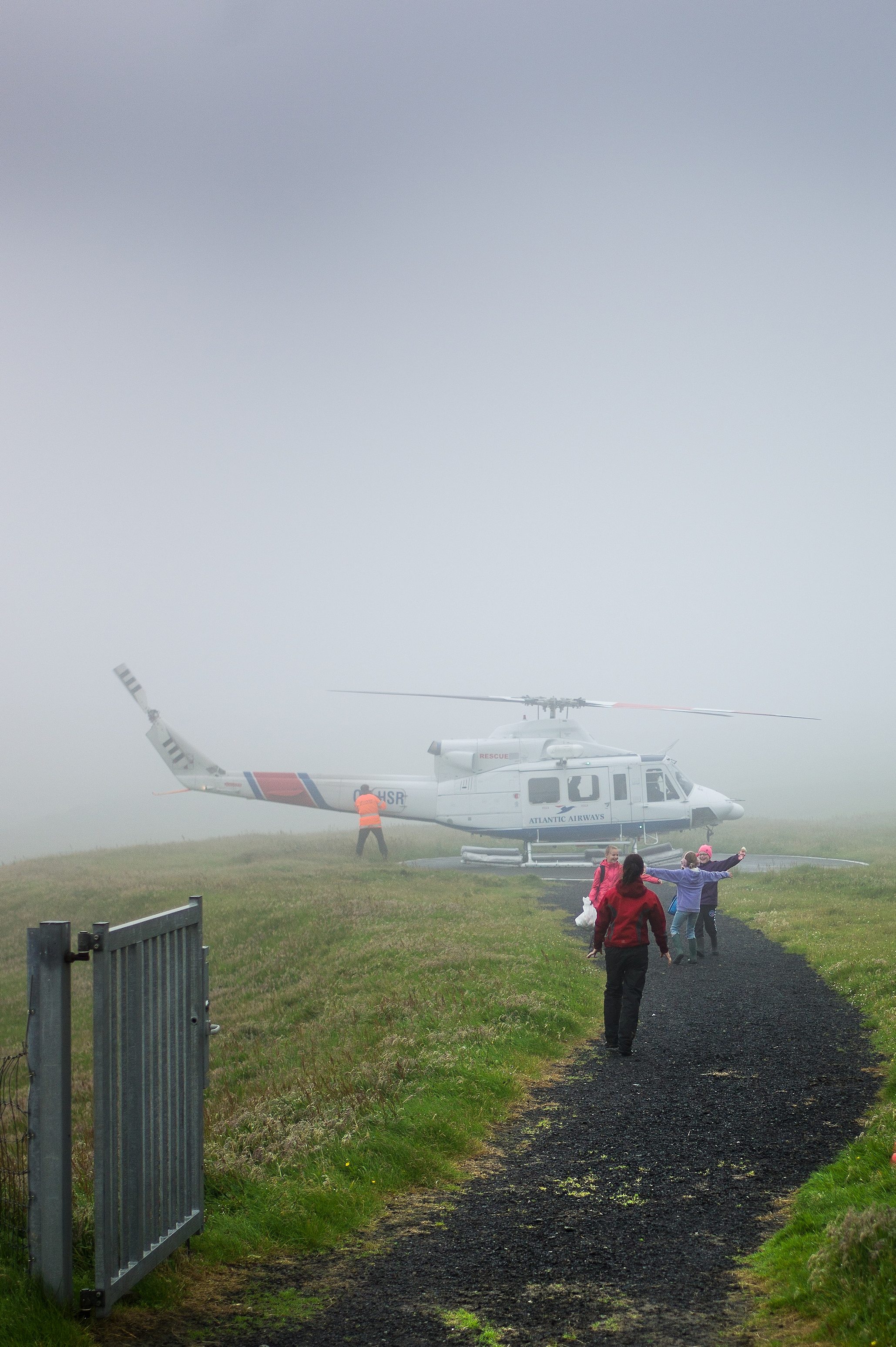
After hanging up his orange in-flight jacket, Jógvan Jón asks me if I want to go with him to round up the sheep on the plateau. After changing and putting on a pair of boots, he stops me and asks how I feel about heights. “Good”, I answer, mostly because I can’t think of another way to answer his question.
In front of us, the slopes leading from the plateau to the edge of the cliff roll out in a soft landscape that looks a bit like it was covered by green cloth from an old pool table. The whole island is both tied together and divided by a network of jagged lines running through the scenery. Like nerves and veins in a human body, light green terraced walkways shaped by 900 years of walking in the same places and equally ancient black stone walls divide the flocks of half-wild sheep.
Suddenly I realize that I can no longer move forward without the use of both hands
As we walk across the slanting grounds, Jógvan Jón points out different things in the landscape: a cliff great for picking northern fulmar eggs (the best for pound cake) in spring, the perfect place to hide when netting puffins in a western wind. He also shows me the best place to pick roseroot, an herb that has become popular in alternative medicine. Roseroot has become an extra source of income for the family on the island, as it has vast quantities of it growing wild. They harvest and dry it before selling it as the base for a tisane.
We walk for a couple of kilometers as Laika, one of the family’s sheepdogs, takes little turns to gather some stray lambs who are grazing in the wrong spot. Little by little the terrain gets steeper and suddenly I realize that I can no longer move forward without the use of both hands; Jógvan Jón keeps a slow but relentless pace upwards and when I stop to catch my breath and to put my camera away in my backpack, I look around me and realize that the formerly gentle slope is now falling away at more than 45 degrees. We continue upwards and soon we are not walking any more but climbing. Laika jumps sure-footedly from stone to stone, higher and higher. As we ascend, we climb into a low cloud parked at the apex of the cliff, and the rising humidity in the air starts to condense on my skin, mixing with sweat and making me soaking wet.
As I approach the end of our climb, my hand reaches in between two rocks and I feel a very familiar scent as I pull myself upwards. There are thyme flowers everywhere. As I stand up on the cliff, their scent fills me as I look back the way we came, out over the sea. The cloud has lifted and the scenery is endless. Jógvan Jón hears my panting breath and says, “A hard day, Magnus, is a good day. A day when you are tired in the evening is a good day.” As we turn around and start walking over the plateau to gather the sheep, the fog once again closes in, and our task becomes impossible. We walk across the plateau and return, carefully, down the incline and back to the house, chatting and looking for a baby Manx Shearwater that we could perhaps bring back for dinner. Still plentiful, these big birds are popular to hunt by the Faroese. The adults are called Skrápur and the young ones Líri. Mostly they are caught in early summer when they are still chicks and salted in barrels to make them keep. Jógvan Jón tells me that we are actually going to eat Líri tonight that were salted last year. He wanted a fresh one to show me the difference.
When Eva’s grandfather was only three months old, his father fell to his death while collecting eggs
We continue talking about wild birds and their historical importance to the Faroese. I ask about harvesting wild eggs and Jógvan Jón tells me that Guillemot eggs were previously harvested in large quantities but no one does it anymore. He points to the cliffs in front of us and shows me a very narrow ledge, running horizontally along the full width of the gray rock. In 1919 when Eva’s grandfather was only three months old, his father fell to his death while collecting eggs, dragging his own father and one more person with him, making the baby boy the only man on the island, growing up only among women. This tragedy due to the dangerous harvest of Guillemot eggs didn’t stop the boy from learning to climb around the cliffs later in life. Today, none are harvested commercially, but fulmar eggs are picked for the family’s own consumption and preserved in water glass (sodium silicate) to keep through winter as are eggs from the ducks and chickens kept at the farm.
As we get closer to the house again, I remember my thoughts about the unusually green grass and I ask Jógvan Jón carefully how the island can be so fertile. Do they use a lot of industrial fertilizer to achieve that kind of green growth? Jógvan Jón looks at me and points towards the cliffs, “We have never used agrochemicals. It is all natural. The fertilization comes from them.” At the cliffs perch tens of thousands of sea birds and I immediately understand: the nitrogen from the birds’ guano is what makes these remote islands almost impossibly lush. Thousands and thousands of kilos of fish every year turn into manure in the digestive tract of puffins, fulmars, guillemots and all kinds of other birds before being naturally spread over the lands. What would happen to coastal farmlands all over the Nordic countries if the North Atlantic seabird populations continue to decline?
Jógvan Jón walks onward. He points down to the water line where the remains of a small concrete structure lie, virtually indistinguishable from the surrounding cliffs. It turns out that where we are standing now used to be the old, pre-helicopter access point to the island. The concrete rubble by the waterline is the ruin of an old boathouse. The rusty remains of a boathouse are perched on the edge of the cliff next to us.
The boathouse, which became a bit less important after the introduction of regular flights, was still being used until recently. In March 2013, a huge storm hit the islands and Jógvan Jón told me that the family was unable to leave their own house. Pebbles and gravel the size of a man’s thumbnail blasted their walls as the wind howled at nearly 60 meters per second. When the storm subsided and the family could once again leave their home, they found that a large chunk of earth had been blown off of the cliffs and crushed the boathouse.
Back in the house, a fishy scent seeps out from the kitchen, as though someone was cooking a fatty fish like mackerel or herring. It turns out to be the Líri, desalted in running water for 48 hours and now braising on the stove. Its fat smells like the very food it eats.

We eat the birds with potatoes—they are delicious. Everyone gets a bird to themselves and a sharp knife to carve away pieces of the braised meat from the bone. The flavor of Líri is special, smelling and tasting like fish. Rarely a good thing when it comes to poultry, here the flavor of the sea is a perfect fit. The oily, fishy scent feels like it belongs there. The fatty, succulent meat makes any sauce redundant.
The next morning is supposed to be my last on the island, but when I wake up the landscape is once again blotted out by dense fog, and it is impossible for the helicopter to land. Eva is nervous because they have just harvested 300 kg of turnips that were to be flown out together with me and sold in various food markets around the islands. If the helicopter can’t make it today, there isn’t another one coming for three more days.
As we sit in the kitchen the voice of the radio newscaster talks about the calm national holiday in Tórshavn but, more importantly, that the EU has launched sanctions against the Faroe Islands because of the fishing quota conflict. Ships bearing a Faroese flag will not be allowed to unload their cargo in European ports anymore and Faroese Herring and Mackerel cannot be sold to the mainland.
As the clock nears 11:44 am, the scheduled arrival of my helicopter, I pack my things and walk toward the helipad with Eva after saying my goodbyes to the kids. We see Jógvan Jón approach in the little blue tractor, its hayfork fully loaded with bright white turnips stacked in 20kg mesh bags.
I can faintly make out the thump-thump-thump of the helicopter rotor churning the damp air, but I can’t see it even as the sound grows in intensity. After a few minutes, the noise abruptly dies away, only to return a moment later. Jógvan Jón speaks in to his handheld radio, communicating with the pilot who can’t see the ground well enough to land. He makes another fly by, followed by one more, and then, on the fifth go, for a brief moment we can sense the heating rays of the sun and a little patch of blue sky surrounded by fog, like a hole in grey cloth, appears above us. The helicopter approaches fast through the hole before conditions deteriorate. I hug Jógvan Jón and Eva goodbye and from the inside of the helicopter I watch them load the sacks of vegetables in the aircraft’s cargo hold before the door is closed and we take off. I wave to the couple standing between their house and the helipad, but I can see them only for a short moment before the fog closes in again.
In an era of growing challenges for our whole planet, Stóra Dímun can serve as an example
During my flight back to Tórshavn I think about life on the island. It is so different in many ways, but the family’s days look much like anyone else’s: much of the everyday concerns and pleasures are the same even though some key practicalities are vastly different. What I find most fascinating, and perhaps even enviable, about life on Stóra Dímun is the almost perfect balance between old and new.
It appears as if Eva, Jógvan Jón and the rest of their family have found a way to use old knowledge and to respect nature without sacrificing the benefits of a modern lifestyle. Compromising a little in each field seems to have made it possible to merge old and new almost seamlessly. In an era of growing challenges for our whole planet, the people on Stóra Dímun can serve as an example. Not to say that a whole world could function with subsidized helicopters and self-sustenance farming, but perhaps the island can serve as an example that old and new can and should work together—and that new isn’t always better.
The lifestyle itself may be impossible to imitate, but their approach to life is applicable anywhere in the world. I believe that Eva and Jógvan Jón might be something completely different than I thought; they might be the most modern family I have ever met.

Formations of Faroese archipelago rush by below me, stone and water blurring and refocusing through the vibrating side window—its opacity directed by the craft’s engine’s changes in frequency, pulsing with the movement of the pilots hand on the throttle, focusing and blurring as we travel. I can hear the two pilots through the helicopter’s communications system. They are talking about the European Union ban on all Faroese ships carrying herring and mackerel in European harbors. The sanctions, which no one here thought would actually happen, had been enacted that morning.